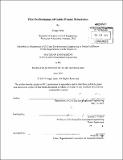Fire performance of gable frame structures
Author(s)
Qian, Congyi
DownloadFull printable version (16.05Mb)
Other Contributors
Massachusetts Institute of Technology. Department of Civil and Environmental Engineering.
Advisor
Jerome J. Connor.
Terms of use
Metadata
Show full item recordAbstract
Fire protection engineering and structural engineering are two relevant but separated fields of study. Many experiments conducted by fire protection engineers are under certain ideal boundary conditions, which may not be applicable for real compartment fires. There is sophisticated software that is able to predict the dynamics of fire indoors, but it requires a lot of computation time and power to run such simulation. The results attained with traditional analytical methods can be extremely conservative, which poses the problem whether or not such approach is necessary; is there a better way to concur on such issues? In recent years, structural engineers have tried to identify ways to optimize structures to make them more efficient for carrying loads such as wind and earthquake. Few studies have been done on structure optimization for fire. As an unpredictable event, fire can occur under many circumstances, such as after earthquakes and blast events. The main cause of structural failure of the World Trade Center towers after the impact was the fire exposure. This thesis outlines a study of three-hinge gable frame's fire performance, and identifies the fire rating differences between testing fire and real compartment fire. Warehouses are commonly built for material storage, which can be inflammable and produce toxins. However, many of them were not designed to withstand unpredictable events such as fire. Therefore, it becomes essential to determine whether or not they have achieved a certain level of fire safety. Steel and timber are two of the most frequently used materials in construction, but when they are exposed to fire, steel losses its strength, and timber burns and losses its cross section area. Three identical gable frames were designed with timber, unprotected steel, and protected steel. All three structures were analyzed with various fire conditions, lab testing fires and compartment fires. The compartment fires were simulated with software called Fire Dynamic Simulator, and the non-linear behavior of timber under elevated temperature was determined using Finite Element Method with ANSYS.
Description
Thesis (M. Eng.)--Massachusetts Institute of Technology, Dept. of Civil and Environmental Engineering, 2013. Cataloged from PDF version of thesis. Includes bibliographical references (p. 49-50).
Date issued
2013Department
Massachusetts Institute of Technology. Department of Civil and Environmental EngineeringPublisher
Massachusetts Institute of Technology
Keywords
Civil and Environmental Engineering.